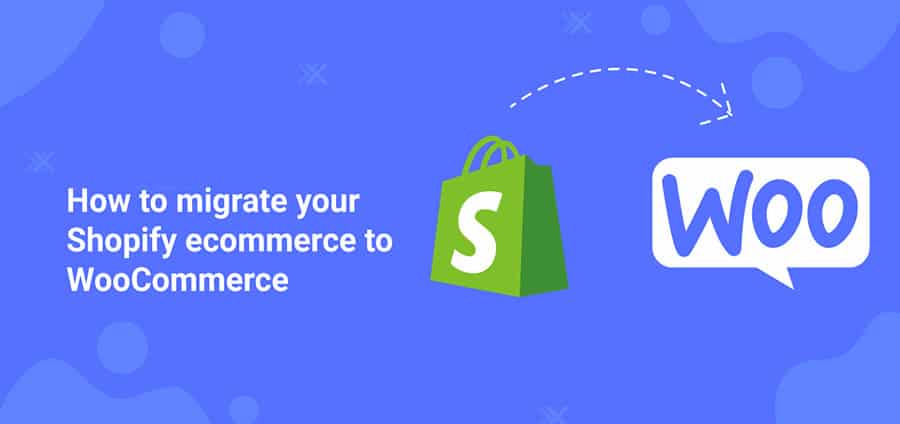Why migrate from Shopify to WooCommerce?
Due to the steadily growing demand for online shop systems (not least fueled by the coronavirus pandemic), the range of e-commerce systems is also growing. The provider market is becoming increasingly confusing, which increases the uncertainty among operators.
In recent years, webshops have become more and more important. Sales in a local store are usually no longer sufficient to run a profitable business. Thus, your own online shop is becoming more and more relevant, at least as a second sales channel, even for smaller retailers.
There are numerous providers on the market who offer a wide variety of shop system solutions. In terms of popularity statistics, Shopify and WooCommerce are among the most widely used e-commerce systems in the world. Both shop systems have advantages and disadvantages and make it very difficult to decide on the supposedly optimal shop system for beginners.
The market shares of shop systems often serve retailers, developers and agencies as a decision-making aid when selecting a system. The decision for a certain system ties up money and resources in the long term. That is why the importance of a shop system plays an important role in the market. The more widespread a shop system is, the greater the chance of meeting an active community and developer community, which also makes the system future-proof.
Top 10 shop systems worldwide (Alexa top 1 million)
- Magento (24,6%)
- Woocommerce (19.8%)
- Opencart (7.4%)
- Prestashop (6.4%)
- Shopify (5.4%)
- Virtuemart (3.5%)
- Interspire
- Oscommerce
- Magento Enterprise
- Big Commerce
Reasons for choosing a shop system.
For online shop operators, choosing the “right shop system” is essential for a successful online business. The most popular shop system is WooCommerce. It is based on the CMS of WordPress. WooCommerce offers a wide range of individual extensions so that the shop fits your requirements profile exactly.
However, you started your business with the Shopify shop system and are just realizing that this is not necessarily optimally set up for your needs? In some cases, it is not the right choice for the German market. Shopify is also simply too complex for small shops and the training and administrative effort are too great. In such cases, it’s a great idea to migrate to an easy-to-manage store system like WooCommerce. How this works and what options are available to you, we have compiled for you in detail in this article.
Shopify to WooCommerce – what are the advantages and disadvantages?
For German-speaking countries, our recommendation for small and medium-sized online shops is the WooCommerce shop system. Shopify now also offers corresponding adaptations for the German market. However, WooCommerce is much better positioned in terms of legal certainty.
For your decision-making, we will show you the advantages and disadvantages in a short comparison of Shopify and WooCommerce:
Shopify:
The e-commerce software Shopify was developed in Canada and was programmed primarily for the North American market.
The shop system is subject to a fee and accounts for about 70 percent of the total market in Canada.
A large number of adjustments have to be made for the German market.
Shopify is mainly used by small and medium-sized shop operators.
Shopify’s global market share is 5.4%
WooCommerce:
WooCommerce is basically a free plugin for the CMS (Content Management System) of WordPress.
The shop system is comparatively easy to adapt to the German market.
WooCommerce is used on more than 14% of all websites that BuiltWith has evaluated worldwide, including sites that do not use e-commerce.
WooCommerce’s global market share is currently 19.8%. It beats Shopify by a wide margin.
Cost
Shopify:
The shop system does not offer a free version.
The system can only be tested free of charge for 14 days.
The standard Basic Shopify package costs 27 euros per month, but is not a real option for an active online store.
The classic variants of Shopify cost between 74 euros and 279 euros per month.
In addition, there are sometimes very high costs for expansions and not inconsiderable costs for transactions.
WooCommerce:
As an open source solution, WooCommerce is completely free.
Many extensions are also free.
However, certain extensions are subject to a fee, but are usually in the lower range up to a one-time fee of €50.00 per plugin.
The plugin “Germanized”, for example, offers all the necessary adaptations to the local (German) market and is free of charge.
Layout and design
Shopify:
There are some free and paid designs.
The design of the standard versions is not particularly appealing.
Design adjustments are only possible to a limited extent.
In order to make advanced changes, a developer is indispensable, which leads to not inconsiderable costs.
A website builder is not available.
This means that the entire design can only be used to a very limited extent.
WooCommerce:
The shop system offers virtually unlimited design options due to the use of WordPress.
There are a large number of free designs, but also many professional paid premium templates.
As a rule, no programming knowledge is required for design adjustments.
The use of website builders is possible.
Ease of Use and Functionality
Shopify:
Shopify is user-friendly and intuitive to use.
Simple inputs and changes can be made without programming knowledge using built-in functions.
However, larger and demanding shop projects require additional expensive applications that require in-depth knowledge of programming.
WooCommerce:
WooCommerce is easy to set up and comes with ease of use.
The user interface is transparent and can be mastered without any problems even for laymen.
Most of the functions necessary for an online shop are already available out of the box.
Desired advanced functions can be installed quickly and without much effort via free or inexpensive plugins.
The case for migrating from Shopify to Woocommerce:
- Easy installation
- No or very lower shop costs
- User-friendly operation without programming knowledge
- Connect to a full-fledged CMS
- Flexibility and high scalability
- Diverse connectivity options
- Ongoing development through open source (large community of developers)
- A variety of free or low-cost expansion options
- Problem support from a huge community
Technical implementation of the migration from Shopify to WooCommerce
1. Manual migration
If you have in-depth programming and technical knowledge, you can perform the migration manually. However, manual migration from Shopify to WooCommerce involves an extensive range of tasks with many challenges. A manual migration is a very complex matter. The export / import can be done in WooCommerce via standard CSV importer for products or also via FTP and phpMyAdmin. You have to generate your own CSV files for users, articles and orders. However, this procedure is only recommended if you are already very familiar with the technical requirements. Since the procedure is very complex, laymen should not dare to do it.
2. Migration via plugin
The easier option is to migrate from Shopify to WooCommerce using migration tools or a plugin. Some of the most popular plugins include: S2W – Import Shopify to WooCommerce or Cart2Cart.
a) Migrate Shopify to Woocommerce using the migration tool “Cart2Cart“
Cart2Cart offers two migration options. With the free demo migration, you can move a limited amount of data to your Live WooCommerce online store. However, this method is only suitable for testing purposes. To complete the Shopify to WooCommerce migration, you’ll need the paid migration tool (base price $29). With it, you can perform the complete migration of all data from Shopify to WooCommerce.
The cost of migrating from Shopify to WooCommerce depends on the total volume of data to be transferred and the options to be transferred (products, categories, customers, reviews, orders, taxes).
The pure procedure for the transfer is intuitive and can be set in individual steps in the Cart2Cart plugin. The WooCommerce shop must of course be set up beforehand if it does not already exist.
In Cart2Cart, the source and destination addresses must be specified with the corresponding URLs. Once the connection is set up, the specific data components to be migrated from Shopify to WooCommerce can be selected. Both main elements and subordinate elements such as product and order information or customer data can be transferred.
b) Migrate Shopify to Woocommerce using the “S2W” plugin
Another alternative to transfer from Shopify to WooCommerce is the “S2W” migration tool. In the tool, enter the appropriate API and the right domain and set the possible options. By clicking on the “Import” button, all data from the plugin is reliably synchronized via the official Shopify API. The plugin is available for free download on WordPress.org . There is no limit to the number of transferable products from Shopify to WooCommerce.
The plugin can be used to import the following file types from Shopify to WooCommerce:
- Store and storage settings with change options for time zone, business address, city, country, state, zip code, time zone, site title, admin email, currency code, currency format, and unit of weight.
- Products with setting and modification options for title, content, variations, excerpt, SKU, stock, product image, variation images, product gallery, weight, categories, regular price, sale price, and tags.
- Customers with setting and change options for first name, last name, company, phone, address, city, province, zip code, country
- Orders with setting and modification options for payment method, shipping method, first name, last name, address, phone, subtotal, total, shipping costs, taxes, discount, currency, line item, discount code, creation date, order number, order fulfillment, browser IP, customer user agent.
- Shipping zones with setting and change options for shipping zones and shipping methods.
- Coupons with setting and modification options for coupon types, coupon amount, minimum amount, usage limit, and expiration date.
- Taxes with setting and change options for country, province, zip code, tax name, tax rate, and shipping.
- Pages with settings and modification options for titles and content.
- Blogs with settings and modification options for blog title, blog content, featured image, categories, and tag.
3. Hire a developer or WooCommerce expert
If you don’t want to do the migration yourself, you can use a developer or expert. This guarantees security and professionalism when importing your data. This saves you a lot of time and problems and you can take care of your daily business in peace. You don’t have to worry about downtime either.
Possible problems that can occur during the migration when using the plugins:
Cart2Cart may experience access lock issues (error codes 301 or 302). If this problem occurs, the position of the connection bridge between Shopify and WooCommerce should be checked and possibly changed.
The bridge is usually located in the root directory of your installation. You may also need to edit the .htaccess file if the bridge is blocked by incorrect instructions or redirects in the .htaccess file. Access problems can usually also be solved by whitelisting Cart2Cart IPs.

